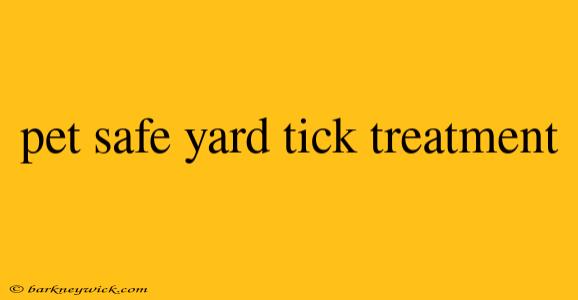Keeping Your Furry Friend Tick-Free: A Guide to Pet-Safe Yard Treatments
I remember the time my dog, a rambunctious golden retriever named Buddy, came home from a walk with a tick embedded in his ear. I was horrified! Ticks are not only unpleasant to deal with, but they can also carry diseases that are dangerous to pets. It was then I knew I needed to find a way to keep Buddy safe from these creepy crawlies.
My Personal Experience and Opinion:
My personal opinion is that while regular tick treatments for pets are essential, it's also vital to treat the environment where they spend time. A tick-free yard is the first line of defense against these pesky parasites. However, I also understand the need for pet-safe solutions, especially with dogs like Buddy who love to roll in the grass.
Objective Facts and Data:
According to the American Veterinary Medical Association, ticks are prevalent across the US, and they can carry diseases such as Lyme disease, Rocky Mountain spotted fever, and ehrlichiosis. These diseases can be life-threatening for pets, so preventing tick exposure is crucial.
Helpful Tips and Advice:
Here are some tips for creating a pet-safe, tick-free yard:
- Regular Yard Maintenance: Keeping your grass cut short and clearing away debris like leaves and brush can reduce tick habitat.
- Natural Tick Repellents: Plant tick-repelling plants like rosemary, lavender, and thyme around your yard. These natural scents can deter ticks.
- Safe Pesticides: If you choose to use pesticides, select pet-safe options. Always read the label carefully and follow application instructions.
- Tick-Control Products: Look for products specifically designed for yard treatment, like [Entity: Bayer's K9 Advantix II for Yard Treatment] which uses a safe and effective formula.
Additional Information:
Here are some important things to keep in mind:
- Check your pets regularly for ticks: This includes after every outing, even if it's just a quick trip to the backyard.
- Use a tick-control product specifically formulated for your pet. Consult your veterinarian for recommendations on the best options for your furry friend.
- Know the symptoms of tick-borne diseases: If you notice any unusual signs in your pet, contact your veterinarian immediately.
Conclusion:
Creating a tick-free environment for your pet is a crucial step in protecting their health. By combining preventative measures like regular yard maintenance, natural repellents, and safe pesticides, you can significantly reduce the risk of tick exposure. Just remember to be mindful of your pet's safety and always prioritize their well-being. My experience with Buddy taught me the importance of proactive tick prevention, and I hope this guide helps you keep your furry friends healthy and happy for years to come.
